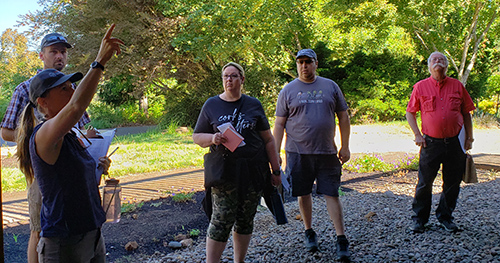By James Day
About 50 people gathered Saturday morning at The Oregon Garden to learn more about wildfire resiliency and emergency preparedness.
Experts from the Silverton Fire District, the Office of the State Fire Marshal and Oregon State University Extension offered tips to the group, which consisted of local residents, environmental activists, fire officials and landscaping professionals.
Key topics covered included wildfire risk evaluation, home hardening, creating defensible space around the home, preparing to evacuate and fire-resistant plants. Participants rotated through four stations in what proved to be an information-packed three hours.
“Something is changing with fire,” said Kayla Bordelon of OSU Extension, in opening remarks to the full group. “We didn’t used to have these large, intense wildfires. And the paradox is that fire is a long-standing part of nature here. Fire was an essential process that cleared out the understory, kind of like a spring cleaning. And with climate change, drier conditions allow fires to burn more intensely.”
Station 1, defensible space
Bordelon, a regional fire specialist for the Willamette Valley and North Cascades, led the defensible space tour stop. The space in question goes from zero to 100 feet from the house or other structure.
About 90% of the fire spread, Bordelon said, stems from flying embers, which means homeowners must be vigilant about embers hopping on “ladder fuels” from a tree to an outbuilding to a deck to the main house.
No vegetation should be within five feet of the house and firewood should be at least 30 feet away. Shrubs should not be clumped together, and flammable items such as benches and trellises should have buffers.
Station 2, emergency preparedness
Four professionals with the Silverton Fire District offered tips on this topic and they noted that most of the items that will help you get through the critical first 72 hours will fit in the common back pack. Firefighter Max Hughes recommended filling your pack in advance and leaving it in a closet by the door so you can pick it up and evacuate immediately should the Level 3 alert hit. Essentials to pack, Hughes said, were food, water, first aid kit, toiletries and toilet paper.
“And don’t forget your dogs and cats,” said Lt. Dan Brown.
A key challenge for rural residents is how to evacuate livestock.
“If you have 30 horses you can’t move them two at a time,” said Keith Veit, assistant chief for Silverton Fire.
Brown added that residents should know alternative routes to get out and to make sure that their address numbers can be easily spotted by first-responders.
Residents also should be careful where they get their information and should only pay attention to trusted, official sources.
Brown told a story of a social media post that indicated that the 2020 Beachie Creek fire had “jumped” The Silverton Reservoir. The fire never got anywhere near the reservoir.
The Silverton Fire District, the OSFM and other fire agencies have started doing home assessments to assist residents. Go to https://experience.arcgis.com/experience/138a924877f145a984ea3b4108edb3ec/
to sign up.
Station 3, fire-resistant vegetation
Brooke Edmunds, an OSU Extension horticulturist, led this group. She emphasized that the goal is NOT to have an empty yard. Instead, she recommended fire breaks between plants and to use fire-resistant varieties.
“Smaller clusters, more empty spaces,” she said. “You don’t have to have a completely barren landscape. You just have to be thoughtful about it.”
The Oregon Garden venue for the workshop produced visible reminders of the dos and don’ts. Edmunds complimented a landscape plot that had plenty of space around plants. But a hillside behind Edmunds contained leaves from last fall and winter as well as shrubs that had grown too close together. And a nearby arbor vitae hedge allowed her to demonstrate that the shrub is a virtual storage cell of flammable materials.
An audience member who works in landscaping recommended the leland cypress as an alternative to arbor vitae.
Station 4, home hardening
Stephanie Stafford of the OSFM led the final session, which focused on the types of building materials that offer the most protection.
Cedar shake roofs are not recommended, with asphalt shingle a good alternative. Stafford noted that a lot of residents in the Santiam Canyon who are rebuilding are choosing metal roofs,
Stafford also noted the importance of cleaning gutters and roofs, especially before fire season. “That’s No. 1, make sure your roof is clean,” she said.
Fiber cement is recommended for siding, with non-wood composite products such as deck boards for porches and decks.
“It’s a fire-resistant composite material that will last for years and you don’t have to stain it,” Stafford said.
